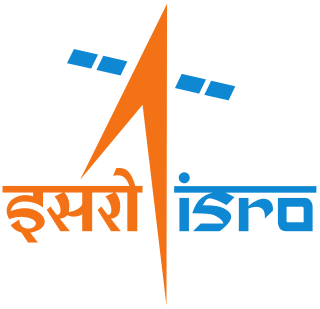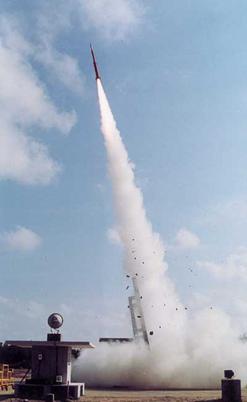Related Research Articles

The Polar Satellite Launch Vehicle (PSLV) is an expendable medium-lift launch vehicle designed and operated by the Indian Space Research Organisation (ISRO). It was developed to allow India to launch its Indian Remote Sensing (IRS) satellites into sun-synchronous orbits, a service that was, until the advent of the PSLV in 1993, only commercially available from Russia. PSLV can also launch small size satellites into Geostationary Transfer Orbit (GTO).

The Indian Space Research Organisation is the national space agency of India. It operates as the primary research and development arm of the Department of Space (DoS), which is directly overseen by the Prime Minister of India, while the Chairman of ISRO also acts as the executive of DoS. ISRO is primarily responsible for performing tasks related to space-based operations, space exploration, international space cooperation and the development of related technologies. ISRO is one of the six government space agencies in the world that possesses full launch capabilities, can deploy cryogenic engines, can launch extraterrestrial missions and operate a large fleet of artificial satellites. ISRO is one of the four government space agencies to have soft landing (uncrewed) capabilities.

Vikram Ambalal Sarabhai was an Indian physicist and astronomer who initiated space research and helped to develop nuclear power in India.
The Vikram Sarabhai Space Centre (VSSC) is a major space research centre and largest base of the Indian Space Research Organisation (ISRO), focusing on rocket and space vehicles for India's satellite programme. It is located in Trivandrum, in the Indian state of Kerala.
Thumba is a coastal area of Thiruvananthapuram city, the capital of Kerala, India.

Satish Dhawan Space Centre – SDSC, is the primary spaceport of the Indian Space Research Organisation (ISRO), located in Sriharikota, Andhra Pradesh.
The Engineering Services Examination (ESE) is conducted by the Union Public Service Commission to recruit officers for the services which cater to the technical functions of the Government of India. It is a three-stage competitive examination comprising objective, subjective and personality tests.

The Launch Vehicle Mark-3 or LVM3 is a three-stage medium-lift launch vehicle developed by the Indian Space Research Organisation (ISRO). Primarily designed to launch communication satellites into geostationary orbit, it is also due to launch crewed missions under the Indian Human Spaceflight Programme. LVM3 has a higher payload capacity than its predecessor, GSLV.

Thumba Equatorial Rocket Launching Station (TERLS) is an Indian spaceport established on 21 November 1963. Operated by the Indian Space Research Organisation (ISRO), it is located in Thumba, Thiruvananthapuram, Kerala, which is near the southwestern tip of mainland India, very close to earth's magnetic equator. It is currently used by ISRO for launching sounding rockets.
Ordnance Factory Board (OFB), consisting of the Indian Ordnance Factories, now known as Directorate of Ordnance was an organisation, under the Department of Defence Production (DDP) of Ministry of Defence (MoD), Government of India. The 41 Indian Ordnance Factories have been converted into 7 Defence Public Sector Undertakings (DPSUs).

The chairman of the Indian Space Research Organisation is the statutory head of the Indian Space Research Organisation (ISRO). The officeholder is a secretary to the Government of India and an executive of the Department of Space (DOS) which directly reports to the prime minister of India.

Waman Dattatreya Patwardhan was an IOFS officer, nuclear chemist, defence scientist and an expert in the science of Explosives engineering. He was the founder director of the Explosives Research and Development Laboratory of India. He is considered one of the distinguished scientists in India due to his contributions to Indian space program, Indian nuclear program and missile program in their early stages. He developed the solid propellant for India's first space rocket launched at Thumba. He was responsible for developing the detonation system of India's first nuclear device which was successfully tested in 1974, an operation codenamed Smiling Buddha.

Nambi Narayanan is an Indian aerospace scientist who worked for the Indian Space Research Organisation (ISRO) and contributed significantly to the Indian space program by developing the Vikas rocket engine. He led the team which acquired technology from the French for the Vikas engine used in the first Polar Satellite Launch Vehicle (PSLV) that India launched. As a senior official at the ISRO, he was briefly in charge of the cryogenics division. He was awarded the Padma Bhushan, India's third-highest civilian award, in March 2019.

Rohini is a series of sounding rockets developed by the Indian Space Research Organisation (ISRO) for meteorological and atmospheric study. These sounding rockets are capable of carrying payloads of 2 to 200 kilograms between altitudes of 100 to 500 kilometres. The ISRO currently uses RH-200, RH-300, RH-300 Mk-II, RH-560 Mk-II and RH-560 Mk-III rockets, which are launched from the Thumba Equatorial Rocket Launching Station (TERLS) in Thumba and the Satish Dhawan Space Center in Sriharikota. The first Rohini rocket was launched in 1967. A later series of ISRO satellites was also named Rohini.
The Indian Ordnance Factories Service (IOFS) is a civil service of the Government of India. IOFS officers are Gazetted defence-civilian officers under the Ministry of Defence. They are responsible for the administration of the Indian Ordnance Factories, which provide the indigenous defence production capabilities of India.
Praful D. Bhavsar is an Indian space scientist who has held several major positions in the Indian Space program including the Project Scientist for the first rocket launch into space from Indian soil on 21 November 1963. In 1986, he retired from the position of Director, Space Applications Centre of the Indian Space Research Organization (ISRO) and the Director, Indian Remote Sensing Satellite Utilization Program.
Eknath Vasant Chitnis is an Indian space scientist and a former member secretary at the Indian National Committee for Space Research (INCOSPAR), which evolved into the present-day Indian Space Research Organisation (ISRO). He is also a former director of Space Applications Centre of ISRO and a former colleague of APJ Abdul Kalam, the erstwhile president of India. The Government of India awarded him the Padma Bhushan, the third highest civilian award, in 1985.
Ramabhadran Aravamudan was an Indian space scientist and engineer who was associated with the Indian space programme from its initial days in 1962. Through his career he served as the director of the Thumba Equatorial Rocket Launching Station, Satish Dhawan Space Centre, and the ISRO Satellite centre. He was a recipient of the 2009 Aryabhata Award from the Astronautical Society of India.

India's Space Industry is predominantly driven by the national Indian Space Research Organisation (ISRO). The industry includes over 500 private suppliers and other various bodies of the Department of Space in all commercial, research and arbitrary regards. There are relatively few independent private agencies, though they have been gaining an increased role since the start of the 21st century. In 2019, the space industry of India accounted for $7 billion or 2% of the global space industry and employed more than 45,000 people. Antrix Corporation expects the industry to grow up to $50 billion by 2024 if provided with appropriate policy support.
Holenarasipuram Govindrao Srinivasa Murthy was an IOFS officer and a space scientist. He was known as one of the "Seven Pioneers of the Indian Space Programme".<He served at the Machine Tool Prototype Factory (MTPF), Ambernath, and as the first Director of the Thumba Equatorial Rocket Launching Station (TERLS), and the Space Science & Technology Centre, now known as the Vikram Sarabhai Space Centre, of the Indian Space Research Organisation (ISRO). He was awarded Padma Shri in 1969 by the Government of India. He interviewed and recruited A. P. J. Abdul Kalam into ISRO.
References
- 1 2 Pushpa M. Bhargava; Chandana Chakrabarti (2003). The Saga of Indian Science Since Independence: In a Nutshell. Universities Press. pp. 39–. ISBN 978-81-7371-435-1.
- ↑ Marco Aliberti (17 January 2018). India in Space: Between Utility and Geopolitics. Springer. pp. 12–. ISBN 978-3-319-71652-7.
- ↑ Roger D. Launius (23 October 2018). The Smithsonian History of Space Exploration: From the Ancient World to the Extraterrestrial Future. Smithsonian Institution. pp. 196–. ISBN 978-1-58834-637-7.
- ↑ Nambi Narayanan; Arun Ram (10 April 2018). Ready To Fire: How India and I Survived the ISRO Spy Case. Bloomsbury Publishing. pp. 59–. ISBN 978-93-86826-27-5.
- ↑ Brian Harvey; Henk H. F. Smid; Theo Pirard (30 January 2011). Emerging Space Powers: The New Space Programs of Asia, the Middle East and South-America. Springer Science & Business Media. pp. 144–. ISBN 978-1-4419-0874-2.
- ↑ "About ISRO - ISRO". www.isro.gov.in. Archived from the original on 28 March 2019. Retrieved 11 September 2019.
- ↑ Mann, Adam (1 March 2019). "ISRO: The Indian Space Research Organization". Space.com. Retrieved 27 March 2019.
- ↑ "'Success is yours, failure is mine' makes one a great leader: Mujumdar". thehitavada.com. 19 September 2021. Retrieved 11 April 2023.
- ↑ Pawar, Ashwini (29 July 2015). "I'm proud that I recommended him for ISRO: EV Chitnis". DNA India. Archived from the original on 9 July 2021. Retrieved 13 July 2021.
- ↑ "About ISRO – ISRO". Archived from the original on 28 March 2019. Retrieved 28 March 2019.
- ↑ Chari, Sridhar K (22 July 2006). "Sky is not the limit". The Tribune. Archived from the original on 19 September 2020. Retrieved 14 March 2021.
